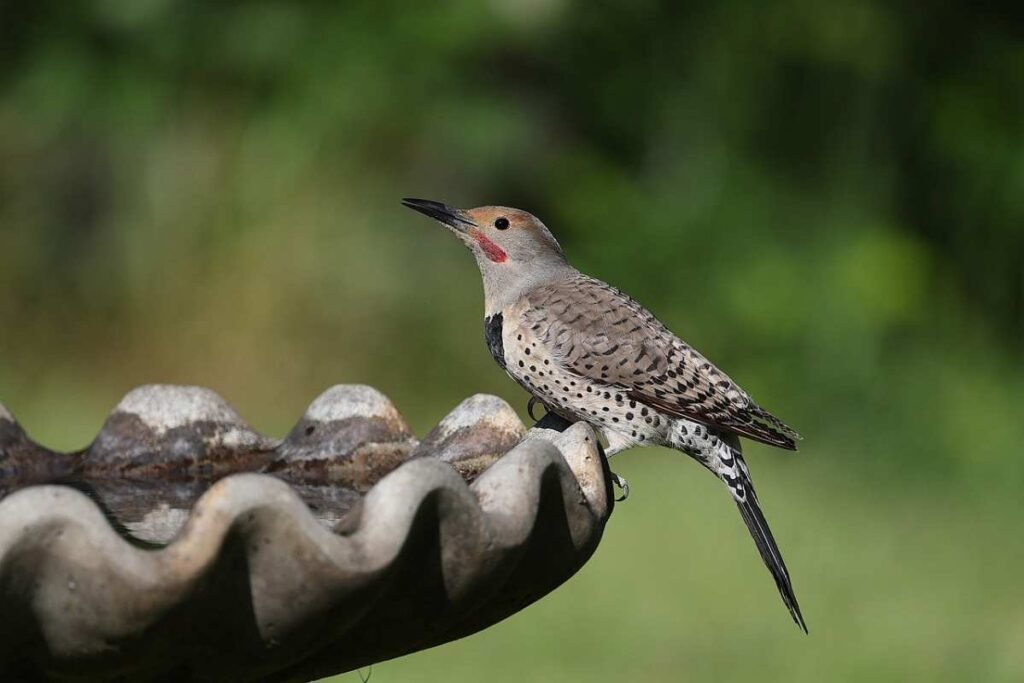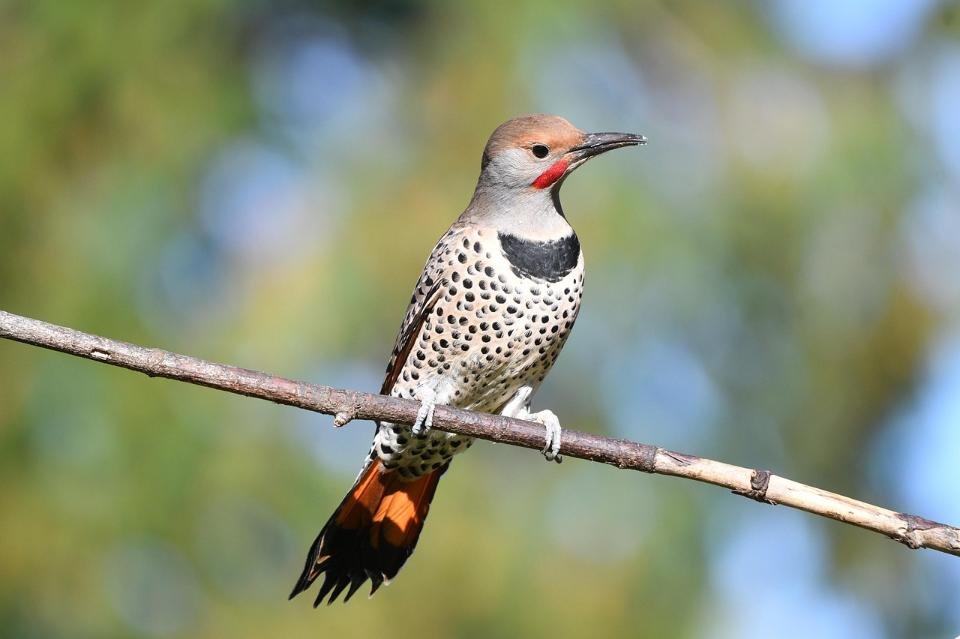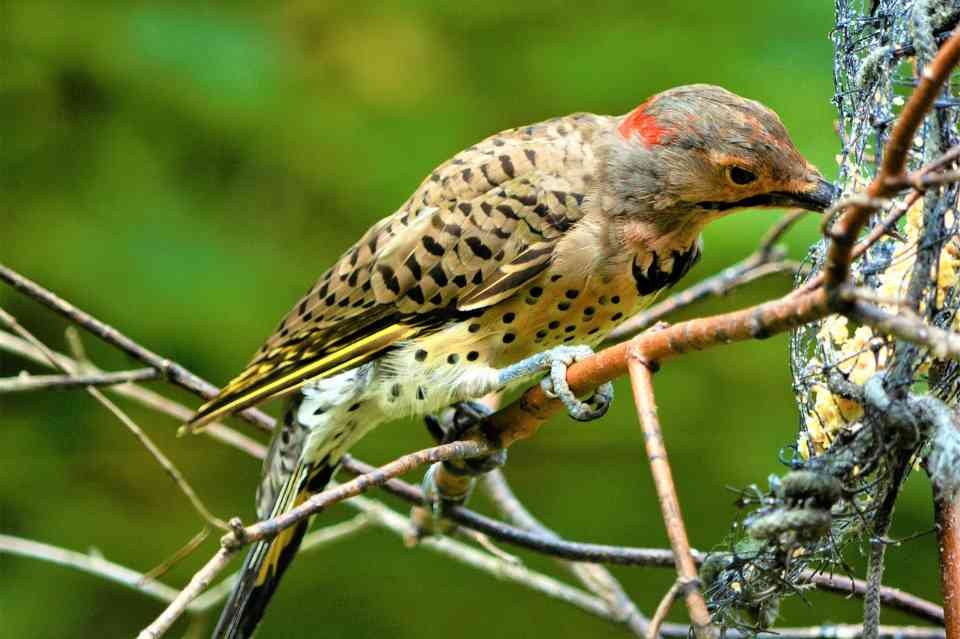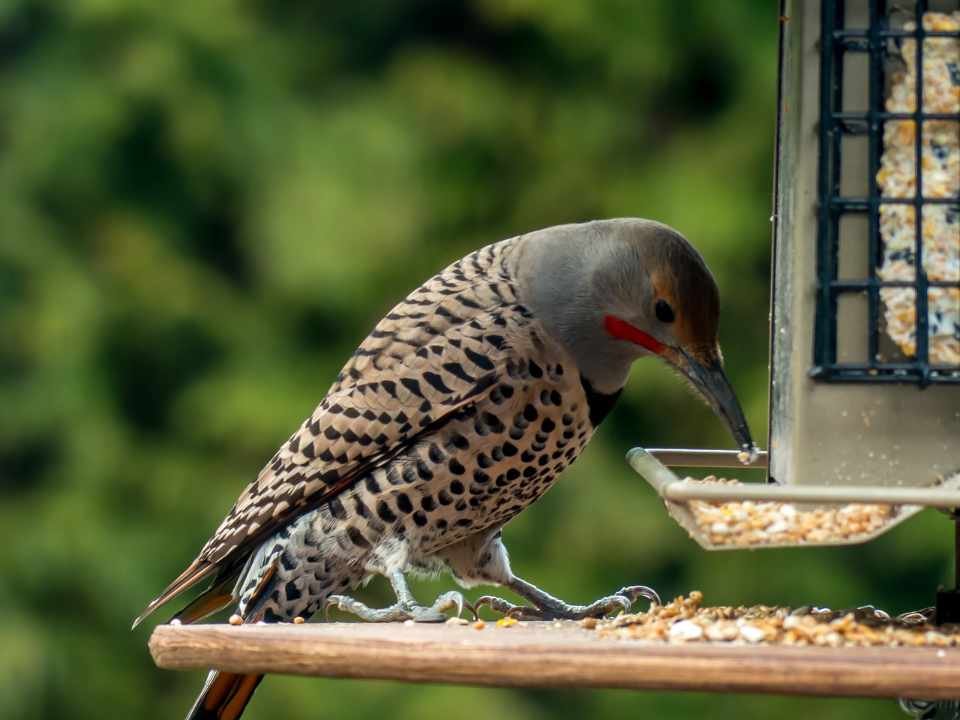You know that moment when you spot a bird doing something completely unexpected and think, “Wait, what the heck are you doing ? 😲” That’s exactly how I felt the first time I watched a Northern Flicker hopping around on my lawn like a robin. If you love quirky avian behavior, stick around, these fun facts about the Northern Flickers will totally blow your mind. Here’s this gorgeous woodpecker, totally ignoring the perfectly good trees around my yard, just casually hunting for ants in the grass like some kind of feathered rebel.
The Northern Flicker might just be the most fascinating rule-breaker in the bird world. These incredible creatures have figured out how to be successful woodpeckers while basically ignoring half the woodpecker handbook. Ready to discover why these birds are absolutely mind-blowing? Trust me, by the time we’re done here, you’ll never look at a flicker the same way again.
They’re Ground-Foraging Woodpeckers (Yeah, That’s Actually a Thing)
Here’s something that’ll blow your mind: Northern Flickers spend more time on the ground than any other North American woodpecker. While their cousins are busy hammering away at tree bark, flickers have developed this amazing ground-hunting strategy that makes them incredibly unique.
These clever birds hop around lawns, fields, and open areas searching for their favorite meal: ants. We’re talking serious ant addiction here. A single Northern Flicker can eat over 5,000 ants in one day. That’s like hitting an all-you-can-eat buffet and actually eating all you can eat.
The Ant-Hunting Technique
Flickers use their incredibly long tongues to extract ants from underground colonies. Their tongues can extend up to 4 inches beyond their bills, which is proportionally longer than most other woodpecker species. I watched one flicker spend twenty minutes working a single ant hill in my backyard, and honestly, the dedication was impressive.
The birds probe the ground with their bills, listening for the subtle sounds of ant activity below. Once they locate a colony, they use that specialized tongue to reach deep into tunnels and extract their prey. It’s like having a built-in fishing rod designed specifically for ant extraction.
Ground foraging makes flickers incredibly efficient hunters during warmer months when ants are most active. This behavior also explains why you’ll often see them in suburban yards, golf courses, and parks where ant colonies thrive in manicured grass areas.
Their Drumming Patterns Are Basically Morse Code
Every woodpecker drums, but Northern Flickers have developed drumming into an art form. These birds don’t just randomly bang on stuff; they create specific rhythmic patterns that serve as complex communication systems.
Flickers produce different drumming sequences for different purposes. Territorial drumming sounds distinctly different from courtship drumming, which sounds different from alarm drumming. It’s like they’ve developed their own percussion language that other flickers instantly understand.
The Science Behind the Sound
Male flickers choose drumming surfaces based on resonance quality. Metal gutters, trash cans, and even air conditioning units often produce the loudest, most carrying sounds. I learned this firsthand when a flicker decided my neighbor’s metal chimney cap was the perfect morning alarm clock at 5:30 AM for three straight weeks.
The drumming serves multiple functions beyond communication. It establishes territory boundaries, attracts mates, and even helps flickers locate insect larvae inside dead wood by listening to changes in the wood’s resonance. Smart birds, these flickers.
Research shows that flickers can distinguish between different individuals based on their unique drumming patterns. Each bird develops a signature rhythm that acts like a musical fingerprint, allowing them to identify neighbors, rivals, and potential mates from considerable distances.
Color Variations That’ll Make Your Head Spin
Here’s where Northern Flickers get really interesting: they come in distinctly different color forms depending on where you find them. The eastern and western populations look so different that ornithologists originally thought they were separate species.
Yellow-shafted flickers dominate the eastern United States and show bright yellow wing and tail feather shafts. Red-shafted flickers rule the western regions with vibrant red-orange coloring in the same areas. The males of each form also display different mustache markings: black for yellow-shafted males and red for red-shafted males. These subtle details are often the easiest way to tell them apart in the field.
Male Red-shafted Flicker
Male Yellow-shafted Flicker
The Great Plains Mixing Zone
The really wild part happens in the Great Plains, where these two forms meet and interbreed freely. Hybrid flickers in this zone display every imaginable combination of yellow and red coloring. Some birds show yellow on one wing and red on the other, creating these absolutely stunning mixed-color patterns.
I photographed a hybrid flicker in Colorado that had yellow primary feathers, red secondary feathers, and a half-black, half-red mustache stripe. Nature definitely has a sense of humor when it comes to these birds.
Genetic studies reveal that these color differences result from relatively recent evolutionary changes. The two forms likely separated during ice ages when populations became isolated, then reconnected as glaciers retreated. Pretty amazing how quickly bird populations can develop distinct characteristics.
They’re Surprisingly Social for Woodpeckers
Most woodpecker species are pretty solitary outside of breeding season, but Northern Flickers break this pattern by forming loose social groups during migration and winter months.
These winter flocks can include 20 or more individuals who forage together in productive areas. They maintain a social hierarchy within these groups, with dominant birds claiming the best feeding spots while subordinate flickers work around the edges.
Migration Mysteries
Northern Flickers migrate in ways that still puzzle ornithologists. Some populations migrate thousands of miles, while others stay put year-round in the same territories. The decision seems to depend on local food availability rather than temperature alone.
I’ve tracked the same banded flickers returning to my yard for five consecutive years, while others disappear each fall and never return. This partial migration strategy allows flickers to adapt to changing conditions while maintaining successful breeding populations.
Flickers migrating through urban areas often stop at the same reliable food sources year after year. Parks, cemeteries, and large residential areas with mature trees become regular stopover points for these traveling birds.
Nesting Habits That Defy Logic
While most woodpeckers excavate nest cavities in dead trees, Northern Flickers choose some seriously weird nesting locations. These birds have been documented nesting in barn walls, fence posts, birdhouses, and even underground burrows. For more detailed information on their nesting habits, refer to the Northern Flicker Life History page.
Bank nesting represents one of their most unusual behaviors. Flickers will excavate horizontal tunnels up to 8 feet deep in earthen banks, creating underground nest chambers that stay cool and protected from predators.
Cavity Construction Skills
Male flickers do most of the excavation work, and they’re incredibly particular about their construction projects. A typical nest cavity takes 12-20 days to complete, with the male working several hours each day to create the perfect chamber.
The finished cavity measures roughly 13-16 inches deep with an entrance hole perfectly sized to exclude larger predators while allowing flickers easy access. Interior walls are smoothly finished, unlike the rougher cavities created by some other woodpecker species.
Both parents share incubation duties, which is somewhat unusual among woodpeckers. They take shifts sitting on their 5-8 glossy white eggs, with changeovers happening every few hours throughout the 11-day incubation period.
Their Tongues Are Engineering Marvels
We touched on tongue length earlier, but the Northern Flicker’s tongue deserves its own engineering degree. This incredible appendage isn’t just long; it’s equipped with specialized features that make it the perfect ant-catching tool.
The tongue tip contains backward-facing barbs that help secure slippery prey. Sticky saliva coating the entire surface ensures that ants can’t escape once contact is made. The tongue also contains pressure-sensitive nerve endings that help flickers locate prey by feel alone.
The Hyoid Apparatus
The hyoid bone structure supporting the tongue wraps completely around the flicker’s skull, allowing for the extreme extension we observe. This bone actually stores the tongue when retracted, coiling around the back and over the top of the bird’s head.
This anatomical adaptation required significant evolutionary modifications to skull structure and muscle development. Flickers have enlarged jaw muscles and reinforced bill structures to support their intensive ground-probing lifestyle.
The tongue can move independently of the bill, allowing flickers to probe around corners and into crevices that would be impossible to reach otherwise. It’s basically like having a Swiss Army knife attached to your mouth.
Seasonal Diet Flexibility
Northern Flickers completely change their diet based on seasonal food availability, showing remarkable adaptability for a specialized species. Summer diets consist of up to 75% ants, while winter menus shift dramatically toward fruits, seeds, and tree sap.
Fall migration timing often coincides with peak berry production, allowing flickers to fuel long-distance flights on high-energy fruit. Dogwood berries, sumac, elderberries, and wild cherries become critical food sources during this period.
Winter Survival Strategies
Winter flickers become surprisingly resourceful foragers. They learn to exploit bird feeders, especially those offering suet, peanuts, and sunflower seeds. Some individuals become regular backyard visitors, showing up at the same feeding stations daily throughout the cold months.
I’ve watched flickers figure out how to use their long tongues to extract peanut butter from specially designed feeders. They also learned to grip suet feeders with their feet while using their bills to extract high-fat food items.
Tree sap becomes an important winter food source in northern regions. Flickers will return to productive sap wells repeatedly, sometimes enlarging holes created by sapsuckers or creating their own tapping sites in maple, birch, and oak trees.
Communication Beyond Drumming
While drumming gets most of the attention, Northern Flickers have developed a surprisingly complex vocal repertoire that includes more than a dozen distinct calls and sounds.
The “wick-wick-wick” call serves as the species’ primary contact call, audible from over a quarter-mile away. Sharp “kyeer” notes function as alarm calls, while soft “yucker” sounds facilitate communication between mated pairs.
Vocal Learning Abilities
Recent research suggests that flickers can modify their vocal patterns based on local dialects and environmental conditions. Birds living in noisy urban areas develop louder, higher-pitched calls that cut through background noise more effectively.
Juvenile flickers learn vocal patterns from their parents and neighboring adults, creating regional dialects that persist across generations. FYI, this vocal flexibility helps explain how flickers have successfully adapted to diverse habitats across North America.
Mated pairs develop synchronized calling patterns during breeding season, with males and females alternating calls to maintain contact while foraging in different areas. This coordination helps them protect territory while maximizing feeding efficiency.
The Urban Adaptation Story
Northern Flickers have become remarkably successful urban birds, thriving in cities and suburbs where many other woodpecker species struggle. Their ground-foraging abilities give them access to food sources that remain abundant even in heavily developed areas.
Urban flickers modify their behavior in fascinating ways. They learn to forage in parks during off-peak hours, avoid areas with heavy foot traffic, and time their activities around human schedules. Some urban populations have even shifted their peak activity periods to early morning and late evening hours.
City Challenges and Solutions
Building collisions represent the biggest urban threat to flickers, particularly during migration periods when birds are unfamiliar with local hazards. Many cities have implemented bird-friendly building designs and lighting ordinances to reduce these risks.
Urban flickers also face increased competition from introduced species like European Starlings, who aggressively compete for nest cavities. However, flickers’ ability to excavate new cavities and use alternative nesting sites helps them maintain successful breeding populations.
Climate change is shifting flicker ranges northward, with southern populations showing declining trends while northern populations remain stable or increase. Urban heat islands may actually benefit northern populations by extending their foraging seasons.
Why Flickers Matter to Ecosystems
Northern Flickers play crucial ecological roles that extend far beyond their impressive individual adaptations. These birds serve as both predator and prey species while creating resources that benefit entire wildlife communities.
Ant population control represents flickers’ most significant ecological contribution. A single breeding pair can remove hundreds of thousands of ants from an area during a typical nesting season, helping maintain balanced insect communities in parks, yards, and natural areas.
Cavity creation benefits dozens of other species who depend on woodpecker excavations for nesting sites. Flicker cavities are eventually used by bluebirds, wrens, flying squirrels, and numerous other wildlife species unable to create their own nest holes.
How to Attract Northern Flickers to Your Yard
Want to see one of these spotted comedians hanging around your place? It’s easier than you think. Here’s how to make your yard flicker-friendly:
- Keep some dead trees or snags, if it’s safe. Flickers love these for nesting.
- Set out suet feeders. They’ll happily snack on suet cakes during winter.
- Skip the pesticides. Flickers need ants and beetles, and chemicals wipe out their food supply.
- Offer a bird bath. Even these busy birds appreciate a good splash.
- Add nest boxes. If you don’t have dead trees, a large woodpecker box works just fine.
Do those things, and you’ll likely have flickers visiting your yard before you know it, hopping around, hunting ants, and showing off their quirky personalities.
Conservation Success Story
Northern Flicker populations remain relatively stable across most of their range, making them a conservation success story in an era of declining bird populations. Their adaptability to human-modified landscapes has helped them maintain healthy breeding numbers.
Habitat management for flickers benefits entire wildlife communities. Maintaining dead trees, preserving open foraging areas, and reducing pesticide use creates conditions that support not just flickers but dozens of other native species.
IMO, the Northern Flicker’s story demonstrates how evolutionary flexibility and behavioral adaptability can help wildlife species thrive alongside human development. These remarkable birds show us that conservation success is possible when we understand and accommodate the specific needs of the species we’re trying to protect.
The next time you see a Northern Flicker hopping around your lawn or hear that distinctive “wick-wick-wick” call echoing through your neighborhood, take a moment to appreciate just how amazing these birds really are. They’ve managed to be successful woodpeckers while breaking most of the woodpecker rules, and honestly, that kind of evolutionary creativity deserves our respect and admiration.





